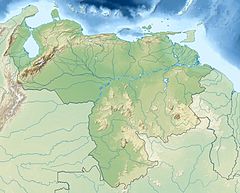
Back متا چایی AZB Мета (рака) Byelorussian Мета (река) Bulgarian Río Meta (suba sa Kolombiya) CEB Meta (řeka) Czech Мета (юханшыв) CV Río Meta German Río Meta Spanish Meta (ibaia) Basque Río Meta French
This article needs additional citations for verification. (May 2014) |
| Meta River | |
|---|---|
 | |
 Course of the Río Meta. | |
| Location | |
| Country | Colombia Venezuela |
| Physical characteristics | |
| Source | |
| • location | Colombia |
| • elevation | c. 1,300 m (4,300 ft) |
| Mouth | |
• location | Orinoco at Puerto Carreño |
• coordinates | 6°11′43″N 67°27′23″W / 6.19517°N 67.4564°W |
| Length | 1,100 km (680 mi) |
| Basin size | 103,000 km2 (40,000 sq mi)[1] to 106,733 km2 (41,210 sq mi)[2] |
| Discharge | |
| • average | (Period of data: 1926-2011)5,694 m3/s (201,100 cu ft/s)[1] to 5,899 m3/s (208,300 cu ft/s)[2] |

The Meta River is a major left tributary of the Orinoco River in eastern Colombia and southern Venezuela, South America. The Meta originates in the Eastern Ranges of the Andes and flows through the Meta Department, Colombia as the confluence of the Humea, Guatiquía and Guayuriba rivers. It flows east-northeastward across the Llanos Orientales ("Eastern Plains") of Colombia following the direction of the Meta Fault.[3] The Meta forms the northern boundary of Vichada Department, first with Casanare Department, then with Arauca Department, and finally with Venezuela, down to Puerto Carreño where it flows into the Orinoco.
The Meta River is 1,100 km (680 mi) long and its drainage basin is 103,000 km2 (40,000 sq mi). The Meta divides the Colombian Llanos in two different parts: the western portion on the left bank is more humid, receives the relatively nutrient-rich sediments from the Andean mountain range and therefore soils and tributaries are also nutrient-rich, while the eastern portion, high plain or altillanura, drains not to the Meta river but to the Orinoco, has a longer dry season and soils and surface waters are oligotrophic (nutrient poor).
The major tributaries of the Meta are the Cravo Sur, the Casanare, the Cusiana, the Upía and the Manacacías rivers.
- ^ a b José Rafael, Córdova; Marcelo González, Sanabria. "La geografía del agua" (PDF).
- ^ a b Félix Dario, Sánchez; Martha, García; Omar, Jaramillo; Nelsy, Verdugo (2010). "Estudio Nacional del Agua 2010".
- ^ Cite error: The named reference
BancoLlanoswas invoked but never defined (see the help page).

